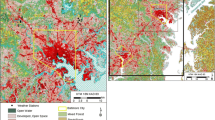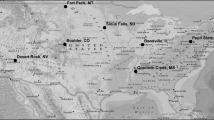Summary
A previously determined model [9], based on the theoretical knowledge of the physical modifications of solar energy by the atmosphere and its transformation at the surface, has been used to determine the monthly distribution of net radiation in southern California at a topoclimatic scale. Parameters utilized in the equations were cloud cover, cloud type, surface albedo, precipitable water vapor, surface temperature, slope angle, slope orientation, elevation, and urban sinog. A remarkable contrast was found between relatively high net radiation values for the littoral and coastal mountains and those of the lower values of the arid eastern parts of southern California.
Zusammenfassung
Zur Bestimmung der monatlichen Verteilung der Strahlungsbilanz in Südkalifornien unter Berücksichtigung des Geländeverlaufs wurde ein vorgängig entwickeltes Modell [9] benützt, das auf der theoretischen Kenntnis der physikalischen Beeinflussung der Sonnenenergie durch die Atmosphäre und ihrer Umwandlung am Erdboden beruht. Die in den Gleichungen verwendeten Parameter sind Wolkenbedeckung, Wolkenform, Erdbodenalbedo, Gesamtwasserdampfgehalt, Erdoberflächentemperatur, Neigung und Orientierung des Geländes, Höhe über Meer und Stadtdunst. Es wurde ein bemerkenswerter Unterschied zwischen relativ hohen Strahlungsbilanzwerten für die Küste und die Küstenberge und niedrigeren Werten für die östlichen Teile Südkaliforniens gefunden.
Résumé
Pour déterminer la répartition mensuelle du bilan de radiation dans le sud de la Californie en tenant compte des conditions topographiques, on utilise un modèle développé récemment [9]. Ce dernier repose sur la connaissance théorique des modifications physiques que subit l'énergie solaire en traversant l'atmosphère et de sa transformation au sol. Les paramètres utilisés dans ces équations sont: la nébulosité, la forme des nuages, l'albédo du sol, le contenu total de l'air en vapeur d'eau, la température à la surface du sol, la pente et l'orientation du sol, l'altitude et la brume urbaine. On a ainsi trouvé une différence marquée entre les valeurs relativement élevées du bilan de radiation valables sur la côte et les régions montagneuses côtières et les faibles valeurs que l'on rencontre dans les parties orientales de la Californie du sud.
Similar content being viewed by others
References
Aeronautical Services Inc.: Sun Angle Calculator. Libbey-Owens-Ford Glass Company, Toledo, Ohio, 1951, 31 pp.
Albrecht, F.: Die Berechnung der natürlichen Verdunstung (Evapotranspiration) der Erdoberfläche aus klimatologischen Daten. Ber. Deutsch. Wetterd.11, No. 83, 1–19 (1962).
Albrecht, F.: Untersuchungen des Wärme- und Wasserhaushaltes der südlichen Kontinente. Ber. Deutsch. Wetterd.14, No. 99, 1–54 (1965).
Ångström, A.: The Albedo of Various Surfaces of Ground. Geograf. Ann.7, 323–342 (1925).
Ashbel, D.: New World Maps of Global Solar Radiation During I. G. Y. Hebrew Univ., Dep. Climatol. Met., 98 pp. Jerusalem, 1961.
Bauer, K. G., andJ. A. Dutton: Flight Investigations of Surface Albedo. Techn. Rep. No. 2, 68 pp. Dep. Meteorol., Univ. Wisconsin, 1960.
Becker, C. F., andJ. S. Boyd: Solar Radiation Availability on Surfaces in the United States as Affected by Season, Orientation, Latitude, Altitude and Cloudiness. J. Solar Energy Science and Eng.1, 13–21 (1957).
Bennett, I.: A Method for Preparing Maps of Mean Daily Global Radiation. Archiv Met. Geoph. Biokl., B,13, 216–248 (1964).
Bennett, I.: Monthly Maps of Mean Daily Insolation for the United States. Solar Energy9, 145–158 (1965).
Bogdanova, N. P., andA. N. Lebedev: The Relationship Between the Weather and Climatic Characteristics and the Radiation Temperature of the Underlying Surface. 17 pp. U. S. Weather Bur. Translation, Washington, 1961.
Brooks, F. A., andW. O. Pruitt, eds.: Investigation of Energy, Momentum and Mass Transfers Near the Ground. 259 pp. Dep. Agricultural Engineering and Dep. Water Sience and Engineering, Univ. California, Davis, 1966.
Budyko, M. I.: The Heat Balance of the Earth's Surface. U. S. Weather Bur. Translation, 259 pp. Washington, 1956.
Budyko, M. I., ed.: Atlas Teplovogo Balansa Zemnogo Shara. 69 pp. Gidrometeorologicheskoe Izdatel'skoe, Leningrad, 1963.
Buettner, K. J. K., as quoted inC. D. Kern: Desert Soil Temperatures and Infrared Radiation Received by TIROS III. J. Atmosph. Sciences20, 175–176 (1963).
Davies, J. A.: A Note on the Relationship Between Net Radiation and Solar Radiation. Quart. J. Roy. Meteorol. Soc.93, 109–115 (1967).
Dickinson, J. E.: Air Quality of Los Angeles County. Techn. Proj. Report, Vol. II, 290 pp. Los Angeles, 1961.
Feldman, E.: USGS Topo Map Land Area and Slope Indicator. 133 Peck Drive, Beverly Hills, California, 1967.
Fons, W. L., H. D. Bruce, andA. McMasters: Tables for Estimating Direct Beam Solar Irradiation on Slopes at 30° to 46° Latitude. 298 pp. Pacific Southwest Forest and Range Experiment Station, Berkeley, California, 1960.
Gates, D. M.: Energy Exchange in the Biosphere. 151 pp. New York, 1962.
Geiger, R.: The Climate Near the Ground. 611 pp. Cambridge, Mass., 1966.
Gloyne, R. W.: A Method for Calculating the Angle of Incidence of the Direct Beam of the Sun on a Plane Surface of any Slope and Aspect. Agricult. Meteorology2, 401–410 (1965).
Johnson, F. S.: The Solar Constant. J. Meteorol.11, 431–439 (1954).
Katlin, N.: The Measurements of the Albedo of a Snow Cover. Monthly Weather Rev.58, 59–61 (1930).
Kern, C. D.: Desert Soil Temperatures and Infrared Radiation Received by TIROS III. J. Atmosph. Sciences20, 175–176 (1963).
Kimball, H. H., andI. F. Hand: Reflectivity of Different Kinds of Surfaces. Monthly Weather Rev.58, 291–295 (1929).
Klein, W. H.: Calculation of Solar Radiation and the Solar Heat Load on Man. J. Meteorol.5, 119–129 (1948).
Kondratyev, K. J., andM. P. Manolova: The Radiation Balance of Slopes. Solar Energy4, 14–19 (1960).
Kung, E. C., R. A. Bryson, andD. H. Lenschow: Study of a Continental Surface Albedo on the Basis of Flight Measurements and Structure of the Earth's Surface Cover over North America. Monthly Weather Rev.92, 543–564 (1964).
Mani, A., O. Chacko, V. Krishnamurthy, andV. Desikan: Distribution of Global and Net Radiation over the Indian Ocean and Its Environments. Archiv Met. Geoph. Biokl., B,15, 82–98 (1967).
Miller, D. H.: Snow Cover and Climate in the Sierra Nevada, California. Univ. California Public. in Geography, Vol. II, 218 pp. Berkeley, 1955.
Monteith, J. L.: An Empirical Method for Estimating Long-Wave Radiation Exchanges in the British Isles. Quart. J. Roy. Meteorol. Soc.87, 171–179 (1961).
Monteith, J. L., andG. Szeicz: The Radiation Balance of Bare Soil and Vegetation. Quart. J. Roy. Meteorol. Soc.87, 159–170 (1961).
Pacific Southwest Forest and Range Experiment Station. Managing Our Snow for a Better Water Supply. 18 pp. Berkeley, 1959.
Page, J. K.: The Estimation of Monthly Mean Values of Daily Total Short Wave Radiation on Vertical and Inclined Surfaces from Sunshine Records for Latitudes 40° N–40° S. New Sources of Energy. Proc. U. N. Conf., Vol. 4, pp. 378–389, Solar Energy, New York, 1964.
Parmelee, G. V.: Irradiation of Vertical and Horizontal Surfaces by Diffuse Solar Radiation from Cloudless Skies. Heating, Piping & Air Conditioning26, 129–136 (1954).
Privett, D. W.: The Exchange of Energy Between the Atmosphere and the Oceans of the Southern Hemisphere. Geophys. Memoirs, No. 104, 61 pp. London, 1960.
Reitan, C. H.: Mean Monthly Values of Precipitable Water Over the United States. Monthly Weather Rev.88, 25–35 (1960).
Sellers, W. D.: Physical Climatology. 272 pp. Chicago, 1935.
Showalter, A. K.: Precipitable Water Template. Bull. Americ Meteorol. Soc.35, 129–131 (1954).
Sissenwine, N., as quoted in Handbook of Geophysics. Geophys. Res. Direct., Air Force Cambridge Res. Labor. 1st ed., Chapter 2, 1957.
Stanhill, G., G. J. Hofstede, andJ. D. Kalma: Radiation Balance of Natural and Agricultural Vegetation. Quart. J. Roy. Meteorol. Soc.92, 128–140 (1966).
Stringer, E. T.: Geographical Meteorology. Weather13, 377–384 (1958).
Terjung, W. H.: Some Maps of Isanomalies in Energy Balance Climatology. Archiv Met. Geoph. Biokl., B,16, 279–315 (1968).
Thrower, N. J. W.: California Population: Distribution in 1960. Map Suppl. No. 7, Annals Assoc. Americ. Geographers56, No. 2 (1966).
U. S. Dep. Agriculture Forest Service: Vegetation Types of California. Berkeley, 1945.
U. S. Dep. Commerce World Aeronautical Chart: Mojave Desert (404), 1965, Gila River (405), ESSA, Coast and Geodetic Survey, Washington, 1967.
U. S. Weather Bur.: Climatography of the United States, Suppl. 1951–1960, California Section. Washington, D. C., 1964.
U. S. Weather Bur.: Daily Series, Synoptic Weather Maps, Northen Hemisphere Data Tabulations. Washington, D. C.
van Bavel, C. H. M., andL. J. Fritschen: Energy Balance of Bare Surfaces in an Arid Climate. Methodology of Plant Eco-Physiology, Arid Zone Research XXV, pp. 99–107. UNESCO, Paris, 1965.
Zeck, G. A.: Personal Communication, 1967.
Author information
Authors and Affiliations
Additional information
With 16 Figures
The aid ofJohn L. Place, University of California, Los Angeles, during the earlier stages of the computations is acknowledged.
Rights and permissions
About this article
Cite this article
Terjung, W.H., Kickert, R.N., Kochevar, R.J. et al. The annual march of the topoclimatic spatial patterns of net radiation in southern California. Arch. Met. Geoph. Biokl. B. 17, 21–50 (1969). https://doi.org/10.1007/BF02248858
Received:
Issue Date:
DOI: https://doi.org/10.1007/BF02248858




